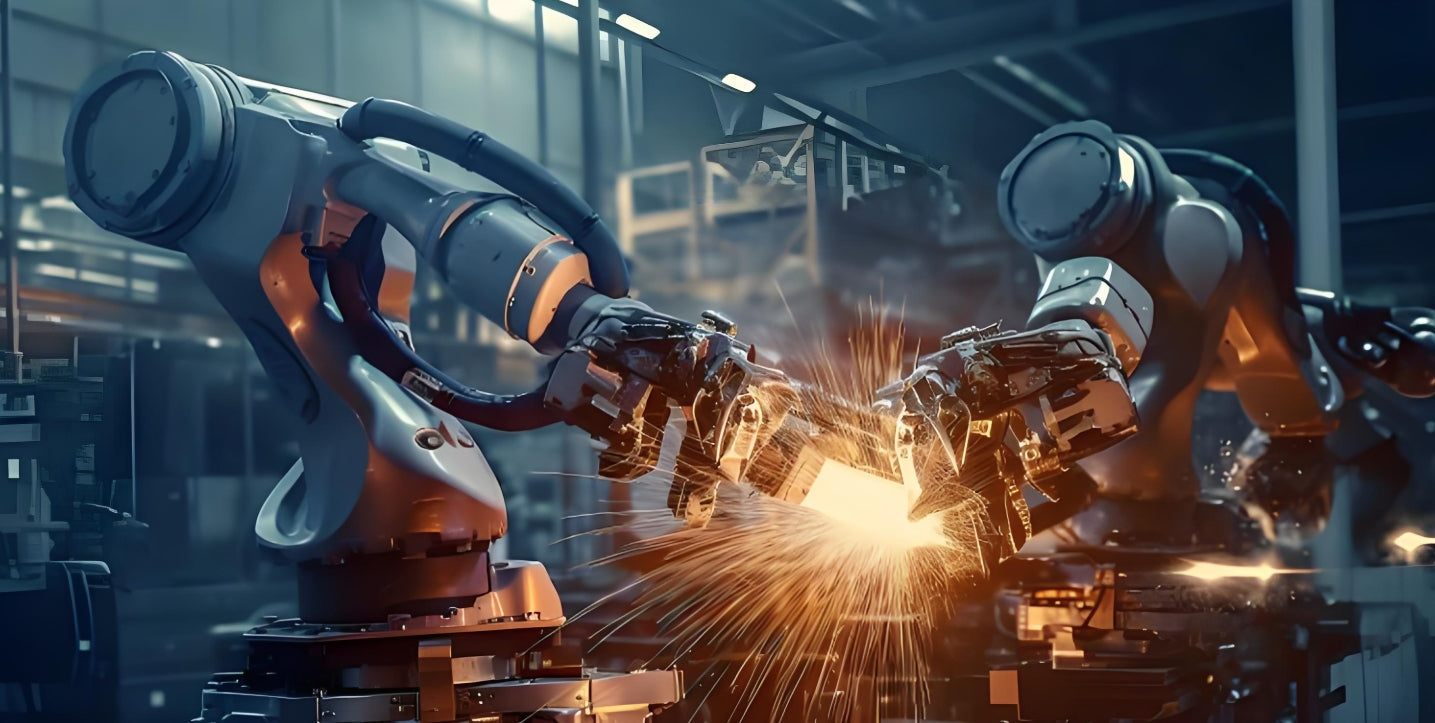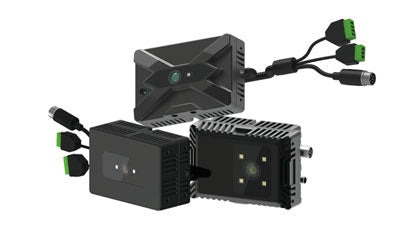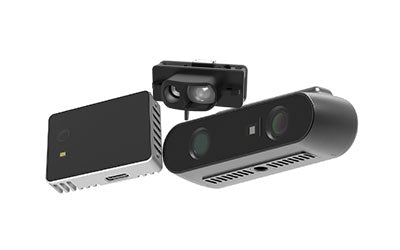TOF in Smart Manufacturing: Ensuring Precision & Efficiency Industry 4

With the comprehensive advancement of Industry 4.0, smart manufacturing has become a key force driving the transformation and upgrading of traditional industries. In this intelligent revolution, automation, precision, and efficiency have become the core demands of the manufacturing sector. As an advanced 3D sensing technology, time-of-flight (TOF) sensor-based 3D sensing is playing an increasingly important role in industrial robot positioning, distance measurement, obstacle avoidance, and other fields thanks to its accurate ranging and rapid response capabilities.
What Are the Advantages of TOF Sensors in Industrial Robot Positioning?
The advantages of TOF sensors in industrial robot positioning mainly include:
-
High-Precision 3D Ranging
TOF sensors measure the flight time of light pulses to quickly and accurately acquire 3D depth information of target objects, achieving millimeter-level or even higher precision distance measurement. This provides industrial robots with precise spatial positioning data, enhancing the accuracy of robotic operations. -
Real-Time and Rapid Response
TOF technology features high-speed responsiveness, capable of capturing spatial changes in dynamic environments in real time, helping robots swiftly adjust their positions and movements, thereby improving production line flexibility and adaptability. -
Strong Anti-Interference Ability
Compared to traditional vision systems, TOF sensors have better resistance to environmental interferences such as changes in lighting, smoke, and dust, allowing stable operation in complex and variable industrial environments, ensuring continuous and reliable positioning data. -
Compact Size and Easy Integration
TOF sensors are compact and low power consumption, making them easy to integrate into industrial robots and other automation equipment, enabling flexible hardware layouts and reducing system complexity. -
Rich Spatial Information
TOF sensors provide not only 2D images but also generate dense 3D point cloud data, helping robots gain a more comprehensive understanding of their environment, supporting complex path planning and obstacle avoidance. -
Support for Multi-Sensor Fusion
TOF sensors can be combined with RGB cameras, LiDAR, and other sensors to improve the accuracy and robustness of robot positioning, enabling smarter environmental perception and autonomous decision-making.
In summary, TOF sensors, with their advantages of high precision, high speed, anti-interference, and easy integration, significantly enhance the positioning capability of industrial robots in complex production environments, promoting automation and intelligence development in manufacturing.

Automation Needs in the Smart Manufacturing Industry
With the rapid development of Industry 4.0 and smart manufacturing, production equipment not only needs to achieve automated operations but also requires intelligent perception and fast response capabilities to adapt to ever-changing and complex production environments. This means equipment must be able to perceive real-time 3D information about their surroundings and accurately identify the position, posture, and status of workpieces, thus enabling flexible and efficient production operations.
Traditional vision systems mostly rely on 2D images, which are sensitive to lighting changes and occlusion and inherently limited in depth measurement, making it difficult to meet the high-precision requirements of complex production lines. Although LiDAR (lidar focusing system) can achieve some degree of 3D ranging, it tends to be bulky, costly, and sensitive to environmental disturbances such as dust and smoke, affecting stability and reliability.
In contrast, the 3D TOF camera solution based on time-of-flight cameras emits and receives light pulses, measuring the flight time of light to quickly and precisely acquire 3D depth information of target objects. It boasts advantages such as compact size, low power consumption, fast response, and strong anti-interference capability. This makes time-of-flight sensing technology an ideal choice for upgrading automation in smart manufacturing.
By integrating high-performance TOF sensors, production equipment can achieve real-time positioning and ranging of complex workpieces, automatically perform key processes such as part grasping, assembly, and quality inspection, effectively improving the automation level and product quality stability of production lines. Moreover, with the detection capabilities of 3D vision inspection, human errors and equipment failure rates can be reduced, leading to comprehensive production efficiency improvements and helping manufacturers gain a competitive advantage in the fierce market.
TOF for Industrial Robot Positioning, Ranging, and Obstacle Avoidance
Based on advanced TOF sensors technology, industrial robots are equipped with high-performance 3D TOF cameras and time-of-flight camera sensors, which achieve millimeter-level accuracy in distance measurement and 3D environment modeling by measuring the flight time of light pulses. This time-of-flight sensing technology can not only rapidly capture spatial information of static objects but also respond in real time to dynamic environmental changes, greatly enhancing the robot’s autonomous positioning and path planning capabilities on complex production lines.
In practical applications, industrial robots leverage the precise distance data provided by TOF 3D sensors to achieve efficient environmental perception and self-navigation, accurately avoiding both moving and stationary obstacles, ensuring production continuity and safety. Especially in multi-robot collaborative scenarios, the time-of-flight camera sensors help robots update environmental models in real time, optimize motion trajectories, reduce collision risks, and improve overall system coordination efficiency.
Moreover, time-of-flight sensors exhibit excellent anti-interference capabilities, maintaining stable operation under conditions such as smoke, dust, and complex lighting environments. This ensures outstanding ranging and obstacle avoidance performance even in harsh industrial settings. Coupled with machine learning and AI algorithms, robots can utilize the dense 3D point cloud data captured by TOF cameras for precise object recognition and dynamic decision-making, further advancing automation levels.
In sectors such as electronics manufacturing, 3C product assembly, and the automotive industry, time-of-flight cameras are widely used in 3D vision inspection and quality control processes. Robots can rapidly identify the spatial positions and morphological changes of tiny components through depth images, effectively reducing defect rates and rework costs, and improving production efficiency and product consistency. By integrating RGBD camera technology, robots not only acquire depth information but also combine it with color images for smarter visual perception to meet the needs of complex tasks.
At the same time, industrial drones equipped with TOF 3D sensors play an important role in logistics, warehousing, and inspection fields. These drones rely on drone obstacle avoidance and drone object avoidance technologies to perceive their surroundings in real time and dynamically avoid obstacles, ensuring flight safety and efficient mission completion. Combined with drone gesture control, drone operation becomes more flexible and intelligent, enhancing drones’ application potential in smart manufacturing.

Robot Positioning
Accurate spatial positioning is the foundation for achieving automated operations of industrial robots in complex production environments. Based on TOF sensors and time-of-flight camera sensors, the flight time of light pulses from emission to return is measured to generate high-precision 3D depth maps, realizing real-time spatial positioning of robots. Compared to traditional 2D vision, TOF 3D sensors provide richer spatial information, helping robots accurately determine their own position and that of workpieces, thereby improving precision in assembly, handling, and other tasks. Combined with multi-sensor fusion and intelligent algorithms, robots continuously calibrate their positions in dynamic environments to ensure operational stability and efficiency.
Robot Ranging
Ranging is a core function for robots to perceive their environment, directly affecting path planning and task execution. The 3D TOF cameras based on time-of-flight sensing can achieve millimeter-level distance measurement and provide high-resolution depth data, accurately measuring both small components at close range and large workpieces at long distances. Compared to traditional laser ranging, TOF camera sensors offer advantages such as fast response, strong anti-interference, and compact size, making them suitable for diverse industrial robot applications. Accurate ranging supports robots in highly automated assembly, inspection, and material handling, boosting production efficiency and product quality.
Robot Obstacle Avoidance
In dynamic and complex industrial environments, obstacle avoidance capability is critical for robots. By using TOF 3D sensors to acquire real-time 3D point cloud data of the surrounding environment, robots can quickly identify the position and shape of various obstacles and promptly adjust their trajectories to avoid collisions. Depth perception based on time-of-flight cameras applies not only to fixed obstacles but also dynamically senses moving personnel, equipment, or materials for flexible avoidance.
Combined with AI and path planning algorithms, robots gain the ability to predict obstacle movement trends, significantly enhancing the safety and continuity of production lines. This technology is also applicable to industrial drones equipped with TOF sensors, enabling aerial obstacle avoidance and ensuring safe and smooth execution of inspection and logistics tasks.
In summary, 3D sensing solutions based on time-of-flight camera sensors not only enhance the precise positioning, ranging, and obstacle avoidance capabilities of industrial robots and drones but also promote intelligent perception and autonomous decision-making on production lines, becoming a key technological support for advancing manufacturing automation in the Industry 4.0 era.

Comparative Analysis with Traditional Vision and LiDAR
Traditional RGBD cameras (rgbd camera) and LiDAR focusing systems (lidar focusing system) can capture 3D spatial information of the environment, but they have certain limitations in industrial applications. Firstly, traditional rgbd cameras heavily depend on lighting conditions and tend to generate noisy data under strong or weak lighting, which affects measurement accuracy. Meanwhile, LiDAR devices are bulky and expensive, and their performance can fluctuate in complex and variable industrial environments due to interference from dust, smoke, and other factors.
In contrast, time-of-flight camera sensor technology based on tof sensors shows significant advantages. TOF (time of flight) sensors precisely measure the flight time of light pulses to calculate distances and exhibit strong anti-interference capabilities. They can reliably operate in harsh industrial environments with smoke, dust, and high humidity, ensuring data continuity and accuracy. Additionally, tof cameras are compact and consume low power, making them easy to integrate into robots, drones, and various industrial automation equipment for flexible deployment.
More importantly, time of flight sensing technology can generate high-density 3D point cloud data in real-time, providing accurate spatial depth information. This data serves as a rich input for advanced machine learning and artificial intelligence algorithms, supporting industrial vision systems in more complex tasks such as 3d vision inspection, defect detection, quality control, and dynamic obstacle avoidance. This greatly enhances the intelligence level and responsiveness of automated systems.
Therefore, tof 3d sensor technology not only outperforms traditional vision and laser solutions in performance but also stands out for its cost-effectiveness and environmental adaptability, becoming an indispensable core sensing technology in smart manufacturing and Industry 4.0 scenarios.
Case Study: 3C Electronics Assembly and TOF Visual Positioning System
In the 3C electronics assembly industry, the variety of components is large and the sizes are very small, requiring production equipment to have extremely high positioning accuracy and fast response capabilities. Traditional 2D vision systems struggle to meet the needs for precise measurement and dynamic adjustment in complex environments. By adopting a high-performance time-of-flight camera visual positioning system integrated with tof 3d sensors, the 3D spatial information of parts can be captured in real time, achieving millimeter-level or even higher precision in positioning and distance measurement.
This system combines advanced depth sensing technology with intelligent algorithms, not only capable of identifying tiny electronic components but also effectively detecting assembly deviations and abnormalities, ensuring product consistency and high quality. Seamless integration with an automated control platform based on yaml configuration enables shared controls and coordinated operations among production equipment, greatly enhancing production line flexibility and adaptability to meet small-batch, multi-variety manufacturing demands.
Moreover, the combination of tof 3d sensors and intelligent vision systems significantly reduces equipment maintenance and manual intervention costs, while improving production efficiency and equipment operational stability. Against the backdrop of Industry 4.0, this technical solution creates an efficient, intelligent, and reliable assembly solution for 3C electronics manufacturers, driving continuous upgrading and innovation in smart manufacturing.
Future Evolution of TOF in Industry 4.0
With the rapid advancement of semiconductor technology (semiconductor chip) and continuous optimization of sensor algorithms, future tof sensors will achieve significant breakthroughs in low cost (3d camera cost), high integration, and miniaturization, further lowering the overall investment threshold for intelligent manufacturing systems. The next-generation tof camera sensors will deliver higher ranging accuracy and wider detection ranges, supporting real-time 3D depth sensing in complex environments.
Furthermore, the smart factory concept emphasized in Industry 4.0 will drive deep integration of building sensors and time-of-flight sensors, enabling comprehensive workshop environmental monitoring and intelligent management. TOF-based 3d sensing will not only optimize spatial positioning of production equipment but also support smart obstacle avoidance and operations for drones, such as combining drone with gesture control for flexible drone manipulation and environmental interaction.
By integrating artificial intelligence and big data analytics, future time-of-flight sensors will evolve beyond mere ranging tools to become intelligent neural centers in industrial production, enabling predictive maintenance, quality control, and safety assurance. This will significantly enhance the automation level and responsiveness of production lines, promoting smart manufacturing towards greater efficiency, safety, and flexibility, making TOF technology a key component of Industry 4.0.
Synexens Industrial Outdoor 4m TOF Sensor Depth 3D Camera Rangefinder_CS40p
After-sales Support:
Our professional technical team specializing in 3D camera ranging is ready to assist you at any time. Whether you encounter any issues with your TOF camera after purchase or need clarification on TOF technology, feel free to contact us anytime. We are committed to providing high-quality technical after-sales service and user experience, ensuring your peace of mind in both shopping and using our products.



